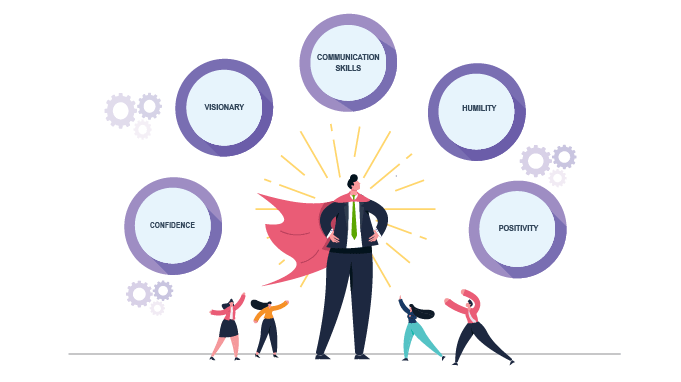9 Most Popular Leadership Styles to Lead Effectively. Find Yours!
Leadership styles are inherent, or they develop with time and practice. It is more than a position of authority. Good leadership is a choice. Even in the most challenging situations, they take accountability for their actions.
But what is the one thing that you need to be a leader? Can you guess?
People! Yes. That's it!
Humans are social animals. When they receive recognition for doing a good job, they are more likely to perform better in the future. But will people follow you even without any extrinsic or intrinsic motivation? Are they willing to follow your lead? Let's find out.

Key Takeaways
- Concept Of Leadrship Styles
- Different Types Of Leadership Styles
- How To Know Your Leadership Style?
What is Leadership Style?
A good leader provides a clear vision of the company's goals and mission. Beyond the profits you make or the numbers at the end of the year, a leader gives a sense of purpose behind one's actions. What is the point of the growth? What is your impact on the company's success?
Leadership styles are how a leader guides a team through different stages. These styles dictate how a leader implements plans, provides guidance, and overlooks work. Based on different personalities and methods, there are many different styles.
The greatest leader is not necessarily the one who does the greatest things. He is the one that gets the people to do the greatest things. – Ronald Reagan.
Now as we have a gist of how a leader impacts the organization as a whole, let's look at the different types of leadership.
Transactional Leadership Style

The task of leadership is not to put greatness into people, but to elicit it, for the greatness is there already.
– John Buchan
What comes to your mind when you see the word “transaction”? In literal terms, it means the agreement to buy or sell something. In this case, the deal is between the leader and followers.
Transactional leadership is a "give and take" scenario. Reward or penalize your employees according to the organization's standards. Everyone knows what to do, why to do it, and to what standard. Evaluation of employee performance happens with predefined criteria and goals.
This style can be effective if the employees are also motivated by perks and benefits. It works best where the tasks are repetitive and goal-oriented.
Key Characteristics of Transactional Leadership Style
- Focuses on concise goal setting and communicating clear expectations to the employees.
- The employees need to be equally motivated by getting the proper amount of rewards and recognition.
- Ideal for large corporations with global teams.
- Transactional leaders prefer typical workflow and satisfy the daily quota.
Pros and Cons of Transaction Leadership Style
Pros
- Favorable in crisis management
- Achievable short term goals
- Clear structure
- Systematic and easy to understand
- Sense of fairness
Cons
- Motivation only through rewards
- Lack of focus on building relationships
- Discourage innovation and creativity
- Lacks long-term goals
- No scope of further development
Works best with large corporations with routine jobs where the team is already motivated and are experts who need a little direction.
Transformational Leadership Style

If you want something new, you have to stop doing something old.
– Peter Drucker
This leadership style believes in the concept of transforming anything into something better. Transformational leaders provide team members with opportunities to explore different ideas and approaches. They let their creative juices flow.
You make your team feel that you care about them by putting them first. You express care and concern for your team members and their problems. It fosters a sense of bonding, belonging, and loyalty towards the organization.
However, relying on praise and nurturing can also lead to mediocre performance over time. It can also result in a lack of strong, clear direction for the company. Leaders should establish a balance to ensure that people don't get too comfortable.
Key characteristics of Transformational Leadership Style
- Works best when you need fresh ideas or new perspectives.
- There is also a particular appetite for risk in this leadership style. It is because leaders are always on the lookout for better ways. It means going out of one's comfort zone.
- This style encourages both the professional and personal growth of the employees.
Pros and Cons of Transformational Leadership Style
Pros
- It gives a lot of freedom to the team members
- It encourages creativity
- It breaks monotony
- It encourages learning and development
- It encourages change
Cons
- Too much focus on the bigger picture
- Regular feedback is essential
- Too much freedom can also be risky
- Not always detail oriented
- It can result in employee burnout
Use this style when your business requires constant innovation and moving ahead of the crowd, such as the internet or IT industries.
Servant Leadership Style

The first responsibility of a leader is to define reality. The last is to say thank you. In between, the leader is a servant.
– Max De Pree
The servant leaders operate on the idea of service first, lead later.
This style of leadership runs on the motto, “You manage other people the way you would like to be managed.” You ensure that everyone knows their job. Ensure that they have all the tools and supplies they need before they begin. If they don’t, you offer them everything they need to succeed.
This style is a favorite among the workers. It works wonders for employee morale and employee experience. But if you don’t balance it, this can lead to your team running the show. It can result in a lack of authority, a little direction, and vision.
Key Characteristics of Servant Leadership Style
- This style has a high degree of awareness toward the team. Leaders of this category are great listeners. It gives them a better understanding of the team’s strengths and weaknesses.
- Great for building respect, trust, and loyalty.
- Helpful in building a solid company culture.
Pros and Cons of Servant Leadership Style
Pros
- It promotes ownership and responsibility
- It increases employee morale and confidence
- It builds trust within the team
- Team members feel valued
- Leaders consider and prioritize employees’ opinion
Cons
- Servant leaders can be perceived as incompetent sometimes
- It can sometimes create confusion
- Slow decision-making
- Team members might not be competent to take decisions
- Leaders lose their authority
Works best for a diverse team, where personalized management is required for each member.
If you want to dig more into this style of leadership, check out our blog here on Servant Leadership!
Democratic Leadership Style

A functioning, robust democracy requires a healthy educated, participatory followership, and an educated, morally grounded leadership.
– Chinua Achebe
Democratic leadership style has what you call the "two is better than one" philosophy. Democratic leaders emphasize the inputs and ideology of workers. The business world also calls it "participative leadership”.
This type of leader makes the final decision. But at other times, democratic leaders may delegate power to followers. Having said that, a democratic leader is not off the hook. They are still accountable for all the outcomes.
This is the decentralized approach to power and authority. (Contrasts with the centralized approach of autocratic leaders, which we will address later.)
Key characteristics of Democratic Leadership Style
- A democratic leader seeks inputs and feedback from followers to make decisions.
- The leader believes that they can make the best decision with lots of inputs from followers.
- Not the best approach for a crisis when there is high pressure and time is short.
- This leadership style emphasizes the aspect of equality in the workplace. Followers of this style take all inputs into account, irrespective of ranks.
Pros and Cons of Democratic Leadership Style
Pros
- Increased staff productivity
- Increased job satisfaction
- Supports diverse ideas
- Improved awareness about company values
- Builds a strong team
Cons
- Shows a lack of expertise
- Chances of dealing with rejection
- Every opinion does not get valued
- Not effective in a crisis
- Results in slow decision-making process
Works best with all kinds of organizations. Although places where strict procedures are required, such as manufacturing industries, democratic leadership is not the best choice.
Autocratic Leadership Style

Nobody is going to delegate a lot of power to a secretary that they can’t control.
– Micheal Bloomberg
How do you picture an autocratic leader?
We picture someone barging into the room and telling people what to do.
As the name hints, autocratic leadership is a boss-centered approach to leadership. The leader has absolute control over the entire operation. They have a top-down approach to communication. They dictate instructions, policies, and activities and expect the followers to comply. You can see high power dynamics going on between the leader and the followers.
Autocratic leaders give little to no importance to socializing and team-building activities. These leaders take no input or feedback from group members. They assess a situation from their own perspective.
Key Characteristics of Autocratic Leadership Style
- Works best when a quick decision needs to be made.
- An autocratic leadership style might help suppress a conflict in the short run. But it does not solve the conflict.
- There occurs a colossal lack of trust in this leadership style on the subordinates. It is why the power to make all the decisions lie in the hands of the leader.
Pros and Cons of Autocratic Leadership Style
Pros
- Leaders have a systematic goal-setting
- They go strictly by the rules
- Highly structured environment
- Good for quick-decision making
- It can help in conflict situations
Cons
- It restricts creativity and innovation
- It can lead to low morale within the team
- Not suitable for companies having a collaborative culture
- It can lack work relationships and connection
- Leaders can lack agility
Best approach when consensus is not possible and the leader is required to make a judgment call.

(Source - https://giphy.com/)
Can you think of someone who projects such qualities as a leader? Please feel free to drop us a mail and let us know if you have any more traits we may have overlooked.
Laissez-Faire (Delegative) Leadership Style

If you pick the right people and give them the opportunity to spread their wings and put compensation as a carrier behind it, you almost don’t have to manage them.
– Jack Welch
"Laissez-Faire" is a French term meaning let do or let them do it. Some critics call it the “Zero leadership” style. It is a philosophy of non-interference. Leaders will give directions or goals and are less likely to check on you. They have fewer meetings and expect you to do it on your own.
Key characteristics of Laissez-Faire Leadership Style
- A laissez-faire leader places a lot of trust in their members and their abilities.
- This management style works by allowing greater employee autonomy. It subsequently adds to more creativity in the workplace.
- Constructive feedback is a vital component of this leadership style.
Pros and Cons of Laissez-Faire Leadership Style
Pros
- Employees get ample room for personal growth
- It encourages learning and development
- It gives employees the freedom to work in their own way
- There is no micromanagement
- Faster decision-making
Cons
- Confusion in the team due to unclear goals
- Too much freedom can lead to isolation and hamper team-building
- It can make leaders less accountable
- It can cause passivity in leaders
- Must have competent team members
Works best if the leader has a group of people who already excel at their skills.
Bureaucratic Leadership Style

The bureaucracy is a circle from which no one can escape. Its hierarchy is a hierarchy of knowledge.
– Karl Marx
Bureaucratic leaders live by the rules. There are certain times that you expect to get things done by “the book.”
You want to get a tattoo and expect the tattoo artist to follow the original procedure. You want to get your car repaired, and you want the mechanic to fix the problem by the rules. Likewise, you want to lead your team by the laws of the book.
Bureaucratic leaders always follow specific rules and stick to those at all times. Yet, this leadership style can be very rigid at times. This rigidity restricts the level of creativity in the process.
Key Characteristics of Bureaucratic Leadership Style
- A bureaucratic leader loves rules, policies and follows procedures meticulously.
Decision-making processes are typically slow-paced. - There is no room for new ideas or innovations. Employees follow routine methods of problem-solving.
- A management approach of this sort is also very well-organized. Leaders here delegate the tasks as per ranks for better results and accountability.
Pros and Cons of Bureaucratic Leadership Style
Pros
- Rigid leadership style
- It does not encourage change and improvisation
- Best suited for large manufacturing organizations
- Quick completion of tasks
- It is predictable
Cons
- No room for creativity
- Lack of competition
- Difficult to adapt to change
- Must follow and go by the rules
- Slow personal growth and development
Works best for large industries such as manufacturing plants where the employees perform routine tasks.
Charismatic Leadership Style

Charisma is the intangible that makes people want to follow you, to be around you, to be influenced by you.
– Roger Dawson
Charismatic leaders are the ones who can walk the talk. The leaders of this style are masters of communication and persuasion with a sense of charm. They have a specific type of appeal, attraction, and magnetism. It helps them gain people to follow their lead. They inspire, excite, and spark enthusiasm among the team members.
Some charismatic leaders that we can think of are Dalai Lama and Obama. They exude warmth and presence when they walk into a room. It is, what they call, the aura!
Some people are born charismatic, and some acquire it with time and experience.
(Recommended blog- What is Charismatic Leadership? Definition, Characteristics, and Benefits! )
Key characteristics of Charismatic Leadership Style
- Charismatic leaders are very confident in their approach. They rarely have any self-doubt about their decisions and possess a very influential personality.
- They have an influence over a large group of followers.
- They fuel the motives of the employees and believe in the ability of the employees.
- They place high expectations and competence and act as a role model for the employees.
Pros and Cons of Charismatic Leadership Style
Pros
- It motivates and inspires the team
- It encourages teamwork and collaboration
- Employee opinions are considered
- It creates a sense of positive change
Cons
- Leaders can be slightly narcissist
- It is often viewed as shallow
- The leaders might become self-centered
- It can sometimes lead to over-promising and under-performing
Works best for social activists, motivational speakers, or political leaders—someone who needs to inspire and gain the trust of their followers.
Leaders like Late Princess Diana, Mahatma Gandhi, Will Smith exude a spark and sense of charm.
Coaching Leadership Style

Leadership is about making others better as a result of your presence. And make sure that impacts last in your absence.
– Sheryl Sandberg
This style of leadership believes in coaching the workers towards greatness. They are usually experts in their field of interest and are great communicators. This type of leadership is most prevalent in sports teams. Yet, it can get troublesome at times as it takes time to mentor and coach the employees.
Key characteristics of Coaching Leadership Style
- Coaching leadership works best with people who have a coaching mindset and are willing to learn from their leaders.
- Leaders also should be ready to spend time and energy coaching their employees to improve them in the long run.
- Empathy and trust are the pillars of this style of leadership.
Pros and Cons of Coaching Leadership Style
Pros
- It gives employees constructive criticism to help them
- It promotes a healthy work environment
- It gives employees the opportunities to become future leaders
- Encourages innovation
Cons
- The leaders must be skilled and competent
- Not all employees can take mentorship positively
- It is time-consuming
- It is applicable only in certain situations
Works best for teams who need to be trained thoroughly to perform to the best of their abilities.
Leadership Style Assessment
As a leader, it is unlikely that you are going to display a single characteristic in your leadership style. You are more likely to carry a mix of leadership styles we have discussed above.
According to David Rooke and William R. Torbert, leaders can be differentiated based on ‘Action Logic’ rather than their personality or management style. So, what is this action logic?
Action logic, as per the duo, is “how leaders interpret their surroundings and react when their power or safety is challenged.” It is based on research conducted by the duo using a psychometric assessment tool called the Leadership Development Profile.
The framework identifies seven distinct "action logics" or leadership styles -
- Opportunist
- Diplomat
- Expert
- Achiever
- Individualist
- Strategist
- Alchemist
These 7 action logics can be sequenced based on their effectiveness. Regarding leading organizations, the least effective types are the Opportunist and Diplomat, while the most effective are the Strategist and Alchemist. Understanding your own way of thinking and acting can be the initial step in creating a more effective leadership approach.
Leaders can evolve from one action logic to the next as they develop greater cognitive and emotional complexity. However, transformation to later action logic like Strategist and Alchemist is rare.
We are sharing a table below with the characteristics and strengths of each leadership style. This will help you understand which characteristics are inherent in you and which you need to foster to reach the next level.
| Action Logic | Characteristics | Strengths |
|---|---|---|
| Opportunist | Egocentric, manipulative, rejects feedback | Can take risks, thinks outside the box |
| Diplomat | Avoiding conflict, supports group norms | Provides social glue, ensures others' needs are met |
| Expert | Rules through logic and expertise, seeks perfection | Improves quality continuously, high individual contributor |
| Achiever | Collaborates, focuses on organizational objectives | Implements strategies effectively, manages performance |
| Individualist | Questions assumptions, communicates across mindsets | Innovates, ignores irrelevant rules |
| Strategist | Focused on organizational perceptions, creates shared vision | Effective change agent, deals with complexity |
| Alchemist | Reinvents themselves and organizations | Integrates material and spiritual, comfortable with ambiguity |
Final Note
Leadership takes skills and hard work to excel in one’s environment. An effective leadership style is not something that is carved in stone. Anyone can pick or drop any leadership style or combine them depending on the situation and people. It depends on one’s resilience, emotional intelligence, and experience while elevating their overall leadership qualities. Keep in mind that it is an ongoing process that solely depends on adapting to the corporate world’s changing dynamics.
Moreover, one of the strongest leadership qualities can be seen in the military. In businesses, we have colleagues and co-workers. In the military, they have brothers and sisters. They might fight and bicker, but when faced with challenges, they stand united.
But how did they create a bond as strong as blood relations out of strangers?
Common values, common beliefs, and a strong sense of belonging.
Help your employees succeed. Help them build their confidence and achieve more than they and you have ever imagined. That’s leadership!


















